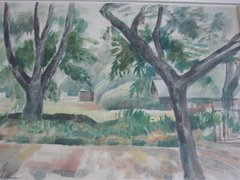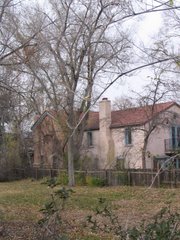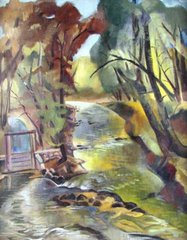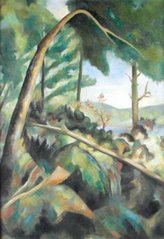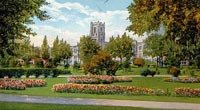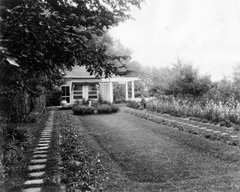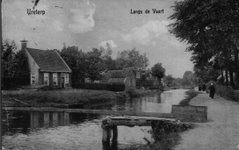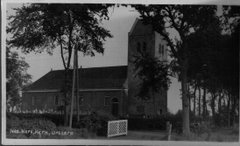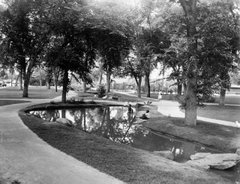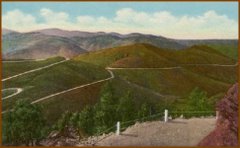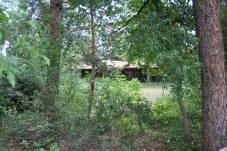Tuesday, March 13, 2007
Compromise Leads to Historic District -- But Threat of Unwelcome Development Lingers
Thankfully as well, the risk of having an important property demolished before neighbors learn of it has been reduced by an amendment to the demolition ordinance that requires two levels of review prior to issuing a demolition permit. This amendment occurred after the DeBoer Neighborhood Preservation Committee was forced to file the landmarking application prior to informing the Trust out of a concern that demolition and deforestation were imminent. The Trust not only did not approach neighbors who had previously indicated a willingness to buy the property, they managed to enter into a development contract in secret to avoid any neighborhood input on the issue. Although the Trust suffered no prejudice from this action since they were given notice and ample opportunity to be heard on numerous occasions, they have been extremely vocal regarding the lack of advance notice. This played into the Trust's slanted and misleading version of events disseminated in their professionally-orchestrated PR blitz that resulted in 2 editorials (one from the Post and RMN), 2 columnists (one from each paper) and several articles that presented a very one-sided picture and hardly touched the historic and cultural significance of Thompson and DeBoer and the arts community they created on the property.
There remains the very real prospect that the Trust will still attempt to achieve their maximum price of $1.99 million (for 17 attached living units) that they believe they are entitled to based on a developer's device known as a PBG. Not available to most homeowners in Denver, the PBG is a tool used by developers and large landowners that gives special treatment to those property owners by allowing them to double the number of housing units they are allowed to build on their property. This means that in an R-2 area such as Pinon Court, a developer only needs 3,000 square feet to justify a housing unit. And developers are allowed to count asphalt streets and cement driveways as "open space."
Pinon Court and the surrounding neighborhood would only see a loss in property values and the quality of life on the Pinon Court cul-de-sac and in the adjoining neighborhood. Such an unwelcome and out-of-character development here could spur long-time homeowners to consider whether to remain in the neighborhood or sell before property values really sink. The combined loss to the neighborhood far exceeds the claimed loss to the Trust, who incidentally, have failed to pay state property taxes on the Dutch cottage that members of the Trust were living in for 30+ years.
The reaction of Pinon Court neighbors who have seen some of the proposed development scenarios by would-be developers has been shock. None of these folks ever believed that it would be possible for someone to essentially wipe out the quality of life in a stable single-family residential neighborhood here on Pinon Court without so much as being required to notify any of the neighbors. The only requirement for a PBG is a notice to the registered neighborhood organization. In this case, that would be the West University Community Association.
It is important for neighbors supporting the historic designation be involved in WUCA (or another neighborhood organization should one be organized). Neighborhood involvement may help discourage another pro-development presentation couched in the guise of a "property rights" of a family of would-be retirees. Their success in convincing a perhaps overly-trusting RNO to vote against the unanimous interests of the Pinon Court neighborhood and in favor of powerful interests who desire to eliminate a city's ability to place reasonable restrictions on development shows how powerful the old "wolf in sheep's clothing" gambit can be.
Saturday, March 03, 2007
John Edward Thompson: Colorado Leader of Vision
Born in Buffalo, New York, Thompson came west for a visit in 1915. He spent 7 months at Pine Colorado turning out numerous landscapes. In 1915 he married a Denver girl and returned to Buffalo where he held an exhibition of his work. In Buffalo, he attracted a group of Polish students who also became exhibitors. Among these first students who also became exhibitors were Alexander Korda, Jozef Bakos and Walter Mruk, who went on to achieve fame in Santa Fe and Taos.
In 1917, Thompson came back to stay in Denver. He was followed by his Polish students and with them, in 1919, held the first exhibition of modern art in Denver. The exhibition caused an uproar in Denver and paintings such as Thompson's "Organization of Rocks and Trees" were ridiculed and shocked citizens wrote letters to the papers. Editorials appeared under the heading "Lenin and Trotsky in Art."
In 1921 he taught at the old Denver Academy of Applied Art and formed a second group of students who, when he resigned from the Academy, left to study under him and later to assist him in executing his numerous mural comissions. among this group were audrey gross, Thomas Aarak, Charles F. Ramus, Frank Vavra, Abbie Candlin, Josephine Hurlburt, Walter Schmitz and Donald Bear.
Controversy did not deter Thompson. He fought for freedom of expression in art his entire life. For his personal talents, dedication to art and to the community, John Thompson came to be know as the "Dean of Colorado Painters."
"I have never in my life met anyone or talked to anyone who knew so profoundly, so thoroughly and yet so simply and directly what constituted great painting. . . I have never met anyone either, that could convey what he knew with such clarity."
----Donald Bear, Director of the Santa Barbara Museum of Art
(sources: Charles F. Ramus, Katelyn Cain on behalf of the Savageau Gallery)
Friday, March 02, 2007
Your Help Is Urgently Needed
Please let the Denver City Council and Mayor Hickenlooper know that you haven't been fooled by the deceptive media campaign against preservation. Know that the property rights of the opposition should not be allowed to usurp the property rights of all of the surrounding neighbors in order to build a cheap and unwelcome townhome development destroying the history and charm of this gentle place.
Please write, e-mail and/or call your city council person and let them know that you support the DeBoer Historic District:
Mayor John Hickenlooper:
Phone: 3-1-1 or 720.865.9000
Fax: 720.865.8787
E-mail: MileHighMayor@ci.denver.co.us Address:
Mayor John W. Hickenlooper
City and County Building
1437 Bannock Street, Suite 350
Denver, CO 80202
To reach all council members:
Fax: 720.865.9540
Address:
City & County Bldg.
1437 Bannock St., Rm. 451
Denver, CO 80202
For individual counsel members: Council Office Links
Please plan to attend the council meeting currently scheduled for March 5 (first reading) and/or the public hearing scheduled for March 12 at 5:30 p.m.
Thank you for supporting preservation of history, culture and the arts in Denver!
Tuesday, February 27, 2007
Frequently asked questions
A: The DeBoer Park neighborhood is unanimous in its support of the proposed historic district and has been helping to enlist additional friends and neighbors in supporting this landmark proposal. The neighbors also uniformly oppose the efforts of the Potts to essentially scavenge their inheritance by selling off the historic homes and landscaping to a developer that will scrape the homes and eliminate most, if not all, of the trees.
Q: Are neighbors opposed to all development?
A: No. What the neighbors oppose is destruction of the historic buildings on the parcel and development that would be far denser than exists on any other parcel in this neighborhood. The Trust is representing this property to potential buyers as bare land, and assure potential buyers that the city would allow 17-units on a space that now contains just 4 living units. Such development would destroy all open space, erase all historic structures and landscaping, and diminish the property values of the rest of the neighborhood by a combined value in excess of $1 million.
Q: What about private property rights?
A: We are strong defenders of private property rights. But exercising one person's property rights should not come at the expense of an entire neighborhood's property rights. If the Potts (or a developer they sell to) are allowed to demolish the historic structures and clear cut the established forest, this destruction will seriously erode the neighborhood's quality of life and will significantly reduce the property values of the neighbors who bought and live in this area solely because of the historic association with DeBoer and Thompson, the self-sustaining forest and the unique cul-de-sac of Pinon Court.
Restrictions on land use, including laws for zoning restricting the use of property and historic preservation, have been upheld since 1926 by the U.S. Supreme Court as a valid exercise of the city’s power to regulate the safety, health and welfare of communities. As noted in a recent article by the National Trust for Historic Places, constitutional rights are duly preserved in historic designation.
Q: Would historic designation prohibit development or sale of the property?
A: No. The historic designation statute preserves irreplaceable structures, permitting both the sale of the property and compatible development on the property. Landmarking designation is actually less restrictive than changing the zoning of the property, which was one alternative that the neighborhood considered. The Potts have been free to sell the property at any time in this process and have turned down more than one offer, including a cash offer of $1.65 million early in this process.
Q: Is the Tudor the most historically significant building on the property?
A: It is only one of several historically significant structures. DeBoer's home is owned by Ana Novas, one of the applicants for historic designation. DeBoer lived in the house for over half a century, originally a tiny farmhouse dating back to the original homesteader in the 1870's. When DeBoer bought the home in the early 20's, he had to engage in a lengthy process of remodelling and enlarging the home so it would be fit for his family. Most of those additions and renovations made by DeBoer exist to this day, including the original Dutch tiles that DeBoer imported from his native Holland that line the fireplace of the Novas home.
The Tudor is the best known structure in the proposed historic district because DeBoer built it in the 1920's as the site of his landscaping architecture and city planning business. The distinctive tower was DeBoer's own creation, patterned after the tower in his hometown of Ureterp, The Netherlands. That tower exists to this day and is the feature most often remembered by both residents and visitors to the area. DeBoer used the tower as his logo for his business and his personal trademark, including it on his official stationery.
The mural studio of John Edward Thompson, known as the dean of Colorado painters, is also a very important structure in the District. The building was designed by the noted architectural firm, Fisher & Fisher; Arthur Fisher was a contemporary and colleague of both DeBoer and Thompson. Thompson started the University of Denver’s School of Art and introduced impressionism to the West.
Q: Is this a hostile designation?
A: No. The proposed historic district includes five lots owned by three owners. Two of owners support designation; one is against. This cannot be called a hostile nomination. A more proper term would be a "mixed" district. In fact, most historic districts in Denver are similarly mixed. Rare indeed is the district in which every property owner supports historic designation.
Q: Were the Potts prejudiced in any way by not having prior notice of the landmarking application before it was filed?
A: No. At the time of the application, the Potts already had development proposals to tear down the structures and were attempting to keep the neighborhood in the dark about their plan.
For the past year, the Potts' have had two separate law firms presenting their ever-shifting arguments opposing the application. They have not been prejudiced by the Applicant’s protective action to forestall demolition. In fact, the use of this issue and the portrayal of the Potts as victims in the massive public relations campaign is simply a red herring, designed to misinform the public and take attention away from what’s really at stake.
It is ironic for the Potts to claim harm from not being informed of the landmark application when they themselves sold the property in secret to a developer who intended to demolish most if not all of the structures and eliminate the trees before the neighborhood got wind of it.
A: Yes, that's true. In 2004, the Potts trapped and gassed an entire family of foxes who had lived in the area for years. It was a minor cause celebre at the time, and even hit the local papers. It was an unfortunate chapter in the history of the DeBoer district and gave the neighborhood a preview of the Potts’ mantra, “my way or the highway.”
Q: Why doesn’t the neighborhood buy the property?
A: A full price offer of $1.9 million was turned down by the Potts last summer. This offer required a longer closing period to enable the neighbors to obtain historic preservation grants. Not only did the Potts reject the offer outright, they raised the asking price, to these buyers only, to $2.2 million.
Q: Did landmark designation scare away a potential buyer?
A: No. The potential buyer, McStain Neighborhoods, has authorized the applicants to state for the record that this contract was terminated for reasons other than the landmark application.
Q: What would DeBoer do?
A: We invite you to read his words, look at the trees he planted, consider his determined efforts over more than 50 years on this site, and ask yourself the same question.
Monday, February 26, 2007
What Would DeBoer Do?
"We mountain staters have in our residential sections something unusual and extraordinary . . . We are far too prone to copy from foreign artists and architects and to forget what we have at home. The open spaces that surround our homes are the greatest single asset of our cities and far surpass the garden city idea, which is of European origin."
_______________
"The story of the trees on Federal Boulevard I wish I could erase from my memory. . . . The trees were fully grown but they had not been watered for several years. . . The park engineer who had neglected the trees had them cut down. it was wholesale slaughter, and I am still ashamed that Denver could have an experience like this."
_______________
"The Denver region is rapidly filling with people. We must expect that our natural beauty is apt to be attacked from all sides and, therefore, those of us who realize that Denver's economic welfare is interwoven with the beauty of its region must take a definite stand to see to it that this is not wantonly destroyed. Some of the work which comes under the name of improvement might well be labelled vandalism."
Sunday, February 25, 2007
DeBoer's Vision for Denver
"When I came to Denver we had a mayor who was interested in trees. Today, City Hall shows no interest in trees. Our streets, now, are for automobiles, sewers and water pipes, not for beauty. Cutting down trees half-a century old seems to be a joy to councilmen and engineers; planting young trees is an act of treason against the city budget. And yet tree planting is ridiculously cheap. Part of this attitude comes from the negative approach to city planning. City planners, now have no knowledge of horticulture and they avoid the subject. Cities are designed according to mathematical formulas which make them bleak and colorless."
"We must not stop in our planning for beauty. Our trees and parks and gardens must be renewed constantly if we are to leave a decent world for those who follow us. Now is the time to plan that world. The city grows so fast that it will soon be too late if the opportunities for making it beautiful are not grasped now."
Will City Council members listen to the words DeBoer has sent us down through the years? Will Deboer's oasis in south Denver be preserved or will it be destroyed? The answer is now in the hands of the City Council -- If you support the preservation of this historic district, please register your support with your council person. See www.deboeroasis.com for more details. Thank you.
DeBoer's City Planning Work -- 1940-1964
- Master Plan for Denver's Parks
- Master Plan for Denver's Mountain Parks
- Ft. Collins, Colorado -- Park & Recreation Plan
- Cherry Hills, Colorado -- Street Plan and Zoning Proposal
- Greenwood Village, Colorado Development Plan
- Boulder, Colorado City Plan (8 vols.)
- Aurora, Colorado -- Building Code, City Plan, Zoning Ordinance
- Grand Island, Nebraska Park & Recreation Plan
- Scottsbluff, Nebraska, City Plan
- Idaho Falls, Idaho, City Plan
- Trinidad, Colorado, City Plan
- Colorado Springs, Colorado -- Plans for Memorial Park, Prospect Lake Recreation Area, Cascade Avenue Plan, Wahsatch Ave. Plan
DeBoer's Influence Wide and Deep
- Charles Gates Home, Bear Creek
- John Gates Home, Denver
- W.R. Owen Residence, Cherry Hills
- F. M. Mayfield Estate
- Mrs. Verner Z. Reed Estate, Denver
- A.C. Foster Estate, Cherry Hills
- Thomas H. Powers Estate, Colorado Springs
- University of Denver, Development Plan
- Park Lane Square, Denver, Development and Landscaping
- Estes Park, Development Plan for Eagle Rock Residential Area
- Estes Park, Development Plan for Stanley Estates
Zoning and Planning Work (pre-1940)
- Denver Zoning Plan
- Englewood Zoning Plan
- Arapahoe County Zoning Plan
- Longmont Zoning Plan
- Boulder Colorado Zoning Ordinance
- Boulder City Nevada City Plan
- Grand Junction City Plan
Friday, February 23, 2007
DeBoer's Outdoor Rooms: Everything Old is New Again
"There are two ways of looking at a garden -- from the outside and from the inside. . . . Not everybody's idea of a garden is to make a decorated street. Most of us want to feel in a garden at least a semi-privacy. We may not want to have the seclusion our rooms give, but we do like to have our garden so that prying eyes of strangers in the street cannot find the quiet nooks in which we like to hide. "
"And here is the first problem we must decide in designing our grounds. How much shall we give up to public use, so to say, by having it open to the street and helping the appearance of the residence from the street? For those who want a secluded outdoor room this space should be kept as small as possible."
Did DeBoer Invent "Xeriscaping"
"As a horticulturist he saw many challenges here -- intense and unveiled sunlight, a semi-arid climate, vast open spaces spread to a wide horizon or rising to the great barrier of high mountains. What plants or trees might frow here other than the familiar cottonwood or alder at the streamside? Could the beauty of the native flora be brought into city gardens? " (from Anna R. Garrey, "The Idea Precedes the Accomplishment.")
As DeBoer himself stated in his autobiography, he joined the Colorado State Forestry Association in an effort to make his quest for a botanic gardens in Denver a reality. As Mr. DeBoer expressed it, he was "so full of the need for a botanic garden he shared his enthusiasm with whomever would listen." The president of the Association for many years, Wm. E. Byers, editor and owner of the Rocky Mountain News, conducted his own experiments with trees, introducting 35 varieties on his home grounds, now Byers Junion High School. Also members of the Association were Walter Cheesman and Henry M. Porter. Their determined daughters, Mrs John Evans and Mrs. James Waring, were critically important in bringing DeBoer's vision of a botanic garden into being.
In 1941, the Association introduced a resolution that a botanic garden be established in Denver to test various tree, shrub and herb species from various climatic zones from the eastern prairie zone to Alpine timberlands. In the "Green Thumb," the Association's publication, Mr. DeBoer wrote in an article entitled "The Colorado Landscape" the following:
"It does seem,however, that in this Rocky Mountain land a type of plant life has found a home which is sturdy enought to withstand the chills and winter and the wither of drouth. . .."
In 1957, the Colorado Forestry and Horticulture Association (the precursor to the Denver Botanic Gardens Foundation) presented Mr. DeBoer with their "Award of Merit" stating, in part:
"You have complemented and enlarged the use of our magnificent native plant material by the addition of hundreds of new species from far afield, but suited to our unusual climate."
The term "xeriscaping" was not actually coined until 1980's when the concept was introduced and trademarked by the Denver Water Board, an organization dedicated to water conservation. But DeBoer acted on the same principles of conservation of water and natural resources when he helped plant the Denver we take pride in today.
How Much Are Denver's Trees Worth?
DeBoer originally aspired to be an architect -- a bridge building engineer who would someday span the canyons of the Alps. He enrolled at the Institute Poutsma. However, fate had other plans. DeBoer became desperately sick (with what turned out to be tuberculosis). The doctor sent him home. That was the end of his pipe dream to become an architect.
His keen eye and architect's sensibility never left him however. He remained acutely aware of Denver's architecture, the good, the bad and the ugly. This is a quote from a letter written by DeBoer to Mayor Quigg Newton upon submittal of a new plan, in 1949, for Denver's growth, paying particular attention to parks:
Denver is building in a very cheap way at this time. The present neighborhoods have lost the attractive building which was done earlier. As a tourist city, Denver cannot afford to retrogress, it must continue its leadership among attractive cities.
As we look forward to the Democratic Convention next summer, Mayor Hickenlooper would be wise to take Mr. DeBoer's counsel to heart. Beauty is not just a luxury for a city. Attracting tourist dollars cannot be accomplished by razing historic structures, clear-cutting mature evergreens, denying our past. DeBoer understood early in the 20th century that beauty can pay the bills.

